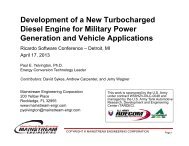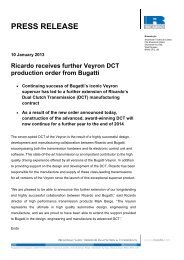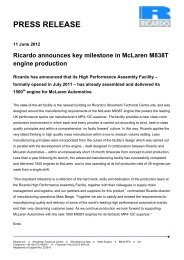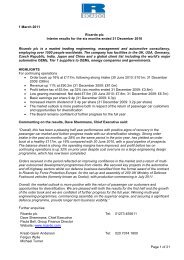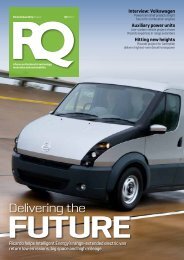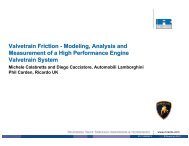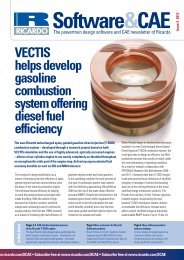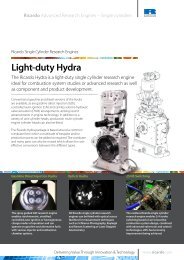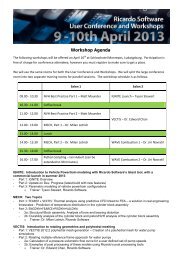Case Study - Ricardo
Case Study - Ricardo
Case Study - Ricardo
Create successful ePaper yourself
Turn your PDF publications into a flip-book with our unique Google optimized e-Paper software.
<strong>Case</strong> <strong>Study</strong>
Hummer H1<br />
HUMMERH1<br />
attains new heights<br />
When GM and AM General decided to upgrade the iconic HUMMER H1<br />
with a larger and more powerful diesel engine, they turned to <strong>Ricardo</strong> in<br />
Detroit, who had earlier helped bring the highly successful H2 vehicle into<br />
being. Jeremy Burne reports<br />
08 RICARDO QUARTERLY REVIEW • Q3, 2005
There is no vehicle on the road<br />
today that quite compares to<br />
the HUMMER H1. Nothing is<br />
quite as big and brawny. Nothing<br />
else has quite the same rugged offroad<br />
capability. Nothing else has the<br />
pure military DNA.<br />
While in industry terms the H1<br />
remains a niche vehicle, it is not one<br />
that flies under the radar. The H1 was<br />
the inspiration behind GM<br />
developing the HUMMER brand, and<br />
although the H2 and the new H3 are<br />
much higher volume products based<br />
on GM truck platforms, the H1 is the<br />
flagship of the HUMMER brand, and<br />
its military heritage is the bedrock of<br />
the brand’s image.<br />
When the H1 was first introduced<br />
to consumers, the manufacturer, AM<br />
General, made some adjustments for<br />
the retail market. After all, the H1 was<br />
based on the US military’s High<br />
Mobility Multi-Purpose Wheeled<br />
Vehicle (HMMWV) commonly known<br />
as the “Humvee”, but consumers were<br />
not going to use the vehicle to go to<br />
war. Amenities such as stereos and<br />
air conditioning are more important<br />
to retail customers than the ability to<br />
mount rocket launchers to the<br />
vehicle.<br />
As with any other vehicle after<br />
years of service, it became desirable<br />
to refresh and upgrade the product.<br />
AM General and General Motors<br />
decided that the H1 deserved a new<br />
lease on life and that the HUMMER<br />
brand would benefit. The result was<br />
the H1 Alpha, which sported a host of<br />
improvements and refinements.<br />
Many of the changes stemmed from<br />
the vehicle’s new engine, the 6.6 litre<br />
Duramax Turbo Diesel and the new 5-<br />
speed Allison transmission. Having<br />
worked with <strong>Ricardo</strong> on the H2<br />
programme, both GM and AM<br />
General were familiar with the<br />
company’s powertrain expertise and<br />
selected <strong>Ricardo</strong> to work on the<br />
integration of the new engine in the<br />
H1 Alpha.<br />
Dan Cowan, senior programme<br />
manager at <strong>Ricardo</strong>, described the<br />
<strong>Ricardo</strong> contribution:<br />
“We are viewed as the powertrain<br />
systems integrator for this<br />
programme, but we were also<br />
responsible for the validation plans<br />
and the whole [product] launch<br />
programme. We believe the reason<br />
why General Motors and AM General<br />
chose <strong>Ricardo</strong> was their confidence in<br />
our wide ranging abilities and<br />
technical depth. These include vehicle<br />
engineering, powertrain engineering,<br />
driveline engineering and production,<br />
and prototype manufacturing and<br />
assembly. We also demonstrated<br />
efficient use of analysis tools and<br />
software systems – this saves our<br />
customers a lot of time and money.<br />
Q3, 2005 • RICARDO QUARTERLY REVIEW 09
Hummer H1<br />
HUMMER H1 Alpha<br />
SPECIFICATION<br />
• Duramax 6600 turbodiesel V8<br />
• Capacity: 6599 cc<br />
• Injection: direct common rail<br />
• Max power: 300 hp<br />
@ 3000 rev/min<br />
• Max torque: 719 Nm<br />
@ 1500 rev/min<br />
• Max engine speed: 3250 rev/min<br />
• Transmission: 5-speed Allison<br />
1000 auto<br />
PERFORMANCE<br />
• 0 – 60 mph acceleration: 13.5 sec<br />
• Can scale 22-inch rock ledge<br />
• Can ford 30 inches water<br />
• Can climb 60 per cent grade<br />
• Can traverse 40 per cent<br />
side slope<br />
• Minimum ground clearance<br />
16 inches<br />
In particular, the cooling system was<br />
an area of concern that <strong>Ricardo</strong> was<br />
asked to revise – there were some<br />
heavy constraints as to what could be<br />
done, so it required some ingenuity to<br />
come up with a solution.”<br />
Integrating the new powertrain<br />
The new H1 Alpha offers customers a<br />
host of improvements over its<br />
predecessor, from interior<br />
refinements to the new Duramax<br />
powerplant and the Allison 1000<br />
transmission. Although the planned<br />
changes made to the vehicle centred<br />
on the integration of the new<br />
powertrain, unanticipated knock-on<br />
effects had to be solved on the fly as<br />
the programme proceeded. Some<br />
sounded simple - the new powertrain<br />
meant new buttons, controls, and<br />
gauges for the dashboard. Others<br />
were more far-reaching – to<br />
accommodate the new engine, the<br />
vehicle body was raised two inches,<br />
reconfiguring the entire body and<br />
chassis interface. There were changes<br />
to the fuel, induction, exhaust and<br />
catalytic converter systems. The<br />
powertrain electrical system was<br />
changed from analogue to digital,<br />
meaning several new wiring<br />
harnesses were needed. The cooling<br />
system was also totally redesigned.<br />
Early in the programme, a team<br />
from <strong>Ricardo</strong> was embedded with AM<br />
General in the Detroit suburb of<br />
Livonia and stayed there for the best<br />
part of the next two years to ensure<br />
close co-operation. In fact, the <strong>Ricardo</strong><br />
team virtually became an extension of<br />
AM General staff for the duration of<br />
the programme.<br />
<strong>Ricardo</strong>’s chief programme<br />
engineer, Tom Reedy, had worked<br />
extensively with AM General and GM<br />
whilst delivering the H2 project and<br />
was well positioned to undertake the<br />
challenges associated with the new<br />
H1 Alpha development.<br />
“The focus of the project was to<br />
integrate an existing and proven GM<br />
truck powertrain into the H1. The<br />
combination of the Duramax Diesel<br />
and the Allison 1000 series<br />
transmission exists already in<br />
Chevrolet’s and GMC’s 2500 and 3500<br />
pickup truck series. In the H1, it offers<br />
more power, more torque and more<br />
refinement, giving the H1 enhanced<br />
performance. The programme focused<br />
on integration of the new powertrain<br />
and ensuring it was emissions<br />
compliant until 2007, at which point<br />
future 2007 heavy-duty vehicle<br />
emissions requirements will start to<br />
apply. AM General provided <strong>Ricardo</strong><br />
with additional resources not<br />
previously budgeted to make the<br />
powertrain and other changes that<br />
were required for commercial<br />
application refinements. The<br />
opportunity was taken to improve<br />
many aspects of the vehicle, and a<br />
real effort was made to improve the<br />
NVH characteristics, particularly<br />
powertrain and driveline NVH.<br />
Tom Reedy details some of the<br />
knock-on changes that were made as<br />
a direct result of the new powertrain:<br />
“AM General were working on a<br />
new interior for the H1, so we had to<br />
work in harmony with AM General<br />
since some aspects of the new<br />
powertrain impacted on their work.<br />
For example, there were new buttons,<br />
controls and gauges on the<br />
Upgrading the H1 with the new engine meant<br />
substantial changes to accommodate the larger<br />
power unit. Even the electrical system had to<br />
be switched from analogue to digital.<br />
instrument panel that were directly<br />
related to the diagnostic capability<br />
and functionality requirements of the<br />
new powertrain. The powertrain is<br />
OBDII certified, so we needed some<br />
extra check lights. Allison asked us to<br />
put in a transmission temperature<br />
gauge. There were also notable<br />
changes in most of the driver<br />
interfaces.”<br />
The H1 gets taller<br />
Replacing a 6.5 litre engine with a 6.6<br />
litre engine might not appear to be<br />
too great a challenge – but things are<br />
not always as they seem. It was<br />
determined at an early stage that the<br />
engine would not easily fit in the<br />
engine bay and that the vehicle body<br />
would have to be raised two inches to<br />
provide adequate clearance. As a<br />
result, the <strong>Ricardo</strong>, GM and AM<br />
General engineers had to reconfigure<br />
“We are viewed as<br />
the powertrain<br />
systems integrator<br />
for this programme<br />
but we were also<br />
responsible for the<br />
validation plans and<br />
the whole launch<br />
programme”<br />
Dan Cowan, <strong>Ricardo</strong><br />
10 RICARDO QUARTERLY REVIEW • Q3, 2005
the entire relationship between the<br />
powertrain, body and chassis frame.<br />
They had to be certain that any<br />
changes did not degrade mounting<br />
and structural performance, ground<br />
clearance, approach angle, ramp<br />
angle or departure angle.<br />
Tom Reedy: ”To clear the top rear of<br />
the Duramax engine, where the<br />
engine housing is quite high up<br />
because of the turbocharger and heat<br />
shields, we had to raise the body<br />
height. We could not degenerate the<br />
ground clearance because of the H1’s<br />
extremely rigorous off-road criteria. In<br />
order to protect ground clearance, we<br />
set the engine up using as a starting<br />
point the same centreline of<br />
crankshaft at the back face of the block<br />
as the old engine. That quickly gave us<br />
an engine position that was realistic<br />
and most effective.”<br />
The ground clearance issue also<br />
required the team to work with GM<br />
Powertrain and Isuzu in Japan to<br />
engineer a new low-profile sump<br />
system and implement several other<br />
engine changes. This required<br />
extensive validation on a dyno at<br />
Isuzu and in the field using class 4 and<br />
5 off-road trails in Moab, Utah.<br />
While raising the body height was a<br />
big decision, there were other areas<br />
that needed to be addressed. For<br />
commercial and technical reasons, the<br />
team worked with AM General<br />
engineers to revise the majority of the<br />
chassis frame system including all of<br />
its crossmembers, the powertain<br />
mounts, and the steering system<br />
mounts. The induction system was<br />
changed to get the optimum flow and<br />
pressure for the engine. The engineers<br />
determined that they needed a high<br />
flow induction system – a clean-sheet<br />
design. The team worked very closely<br />
with the induction system vendor to<br />
make sure the system was just right.<br />
They also changed and re-routed the<br />
complete exhaust system, moving to<br />
larger 3-inch (75 mm) and 4-inch (100<br />
mm) diameter pipes to get the correct<br />
flow and appropriate back pressure.<br />
Driveline<br />
At the same time, the team had to<br />
look at some significant changes to<br />
other driveline components. As the<br />
new powertrain package was<br />
physically larger, it was necessary to<br />
introduce a completely new front<br />
propshaft, which required double<br />
cardan joints as opposed to single<br />
universal joints, to allow for the larger<br />
driveline angles. From an axle<br />
perspective, the existing 2.56:1 axle<br />
Q3, 2005 • RICARDO QUARTERLY REVIEW 11
Hummer H1<br />
Redesigned Cooling System<br />
With a new 6.6 litre engine producing 300 horsepower<br />
and 520 lb-ft (705 Nm) torque, it is not surprising that the<br />
cooling system would also be an issue for the AM<br />
General and <strong>Ricardo</strong> engineers to resolve. Heat rejection<br />
from the Duramax 6.6 litre is significantly greater than for<br />
the previous 6.5 litre engine – so as a result a larger<br />
cooling pack was needed, incorporating six separate<br />
component-specific coolers.<br />
As Reedy explains, “We knew that the old engine<br />
cooling fan, at wide open throttle, was capable of<br />
drawing about 4200 cubic feet (120 m3) per minute of air<br />
through the cool pack. Clive Hughes and his Thermal<br />
Systems team at <strong>Ricardo</strong> did some early comprehensive<br />
analysis work and determined that we needed to draw<br />
more like 7900 cubic feet per minute through the cool<br />
pack to get the right amount of heat rejected. The big<br />
problem was we had a fixed volume available for the<br />
cool pack due to vehicle constraints. There was a radiator<br />
cooler, a charge air cooler, an AC condenser, a fuel cooler,<br />
a transmission oil cooler and a transfer case cooler – all<br />
those things had to be stacked up in series in the cool<br />
pack, a difficult scenario to manage.”<br />
The thermal systems team executed a suite of analyses<br />
to model the whole vehicle cooling system in virtual<br />
space. <strong>Ricardo</strong>’s proprietary analysis software allows its<br />
own engineers and its customers to set up a totally<br />
integrated, holistic thermal system model of powertrain<br />
heat rejection. A number of software tools are linked<br />
together so a complete system model can be run in a<br />
virtual wind tunnel.<br />
Tom Reedy: ”We can simulate the vehicle climbing a<br />
steep grade with a loaded trailer and four passengers<br />
“The end effect<br />
of three months of<br />
modelling work was<br />
a fully working<br />
virtual model of<br />
the entire cooling<br />
system.”<br />
Tom Reedy, <strong>Ricardo</strong><br />
required <strong>Ricardo</strong> to work closely with<br />
Dana to develop low motion transfer<br />
error (MTE) gears by close matching<br />
the ring and pinion system. This<br />
resulted in a significant reduction in<br />
axle gears motion transmission error.<br />
The <strong>Ricardo</strong> team worked on the<br />
outboard geared wheel hubs, which<br />
are a characteristic of the H1. Previous<br />
straight-cut spur gears were replaced<br />
with helical-cut gear sets to reduce<br />
the gear growl noticeable during<br />
vehicle deceleration.<br />
Upgraded electrical system<br />
The previous H1 had an electrical<br />
system that was based on an<br />
analogue electrical architecture. The<br />
Duramax engine is a GM Class II<br />
digital powertrain with digital engine<br />
and transmission controls, so it is not<br />
surprising that some work needed to<br />
be done on the vehicle electrical<br />
infrastructure to make the powertrain<br />
system work in the truck.<br />
Tom Reedy: “We had to establish the<br />
‘least pain’ route for doing this – least<br />
time, least cost. One option was to<br />
create a body control module (an A/D<br />
and D/A converter) and everything<br />
would go through that as<br />
a funnel backwards<br />
and forwards as a<br />
total<br />
communication<br />
system. This<br />
could have been<br />
very problematic<br />
had not Delphi<br />
stepped in to<br />
support the<br />
development of a<br />
customized Engine<br />
Control Module solution<br />
for us. “<br />
Geared fan drive<br />
One of the key components<br />
that changed as a result of the<br />
cooling pack modelling (see panel)<br />
was the radiator cooling fan. In the<br />
H1, the radiator lies at an angle, rather<br />
than in the conventional upright<br />
position. The solution required a<br />
Geared Fan Drive (GFD) that created a<br />
much higher level of efficiency<br />
between the fan and the radiator so<br />
the fan required less energy to suck<br />
air though the radiator.<br />
The system was designed by<br />
<strong>Ricardo</strong> DTS (Driveline and<br />
Transmission Systems) in the UK –<br />
and all prototypes and initial<br />
production units were made by<br />
<strong>Ricardo</strong> until a production supplier<br />
could be brought up to speed.<br />
Designing, validating and<br />
manufacturing this unit within five<br />
months was quite an undertaking,<br />
given that the usual timeframe for<br />
such development is 12 to 14 months.<br />
This GFD solution is not only<br />
effective for AM General’s commercial<br />
customers. Rod<br />
Hall, who races<br />
HUMMERs in the<br />
gruelling Baja desert races, tried out<br />
an early production version of the<br />
new geared fan drive system in one of<br />
his race vehicles and went on to win<br />
the 1000 mile race.<br />
Another benefit of <strong>Ricardo</strong>’s<br />
changes to the cooling pack was that<br />
the vehicle’s towing capacity<br />
increased from 5000 lbs to 7000 lbs –<br />
a valuable selling point to HUMMER<br />
consumers.<br />
At the plant<br />
<strong>Ricardo</strong> engineers not only helped<br />
develop the vehicle but they were<br />
also on hand to support the plant<br />
launch, from pilot builds through to<br />
The new Duramax engine (above) is longer<br />
and taller than the outgoing unit; <strong>Ricardo</strong><br />
designed, validated and built the upgraded<br />
cooling system within five months.<br />
12 RICARDO QUARTERLY REVIEW • Q3, 2005
and we can see how much heat the powertrain is rejecting,<br />
we can see what the airflow coming in through the front of<br />
the vehicle is doing, we know how much air we are getting<br />
through the cool pack, and finally how much heat we are<br />
rejecting. Then we can begin to work on the size, shape and<br />
placement of the coolers to get the optimum amount of<br />
heat rejection. We did this using the <strong>Ricardo</strong> VECTIS CFD<br />
package in the form of a virtual wind tunnel. We linked this<br />
to a package called FLOWMASTER, which is a 1D<br />
hydraulic and thermal analysis package, and EASY5, which<br />
allowed us to model the vehicle driving under various<br />
loads and conditions. The end effect of three months of<br />
modelling work was a fully working virtual model of the<br />
entire cooling system. This approach allowed us to size<br />
correctly the first prototype parts. During our first thermal<br />
test trip to Death Valley in California, the vehicle met its<br />
cooling requirements.”<br />
Job One Launch and for the first<br />
ninety days of production. This<br />
included having a staff member on<br />
site at the plant as a liaison engineer,<br />
as well as whole team support every<br />
time a vehicle was built. As a result,<br />
any problems could be solved rapidly,<br />
and any design changes that needed<br />
to be made to help the production line<br />
could be expeditiously implemented<br />
and released. Within six months, all<br />
engineering-related build issues had<br />
been resolved.<br />
Customer satisfaction<br />
Richard Fanco, chief engineer of the<br />
H1 Alpha programme, worked<br />
extensively with <strong>Ricardo</strong> during the<br />
development of the new truck.<br />
“The HUMMER H1 Alpha<br />
programme would have normally<br />
been done on-site with AM General<br />
resources. Due to timing, AM<br />
General’s full focus was on our<br />
military customer products. We<br />
needed a consulting group that would<br />
work on-site so our engineering staff<br />
could provide guidance in a VSE<br />
(Vehicle Systems Engineer) role and<br />
allow our engineering staff to<br />
maintain full focus on our military<br />
customers’ needs.<br />
“While working on upgrading the<br />
military HMMWV, we recogised that<br />
there were some features that could be<br />
incorporated into the commercial<br />
vehicle programme. One of these was<br />
the geared fan drive – cooling is always<br />
an important issue with an on/off road<br />
vehicle like ours.<br />
“NVH has always been a focal point<br />
with the vehicle. Whether it was<br />
powertrain, driveline or road noise<br />
related, reducing noise has always<br />
been a goal. <strong>Ricardo</strong>’s NVH expertise<br />
allowed for co-ordination with our<br />
geared hub supplier and converting to<br />
a helical gear design gave us two<br />
things – additional strength and<br />
reduced noise. The <strong>Ricardo</strong> team also<br />
worked with our suppliers to reduce<br />
propshaft and axle vibration and noise.”<br />
“In addition, some of the<br />
programme management tools that<br />
<strong>Ricardo</strong> brought to the programme<br />
worked very well – they had a number<br />
of tracking systems and procedures in<br />
place that were very useful in the<br />
programme. We at AM General are<br />
starting to incorporate some of these<br />
tools, tailored to our needs, into other<br />
AM General programmes. The fact<br />
that <strong>Ricardo</strong> provided in-house<br />
support on this programme provided<br />
for a good interface opportunity.”<br />
The Alpha performs<br />
H1 fans and customers will be pleased<br />
with the numerous improvements that<br />
the GM, AM General and <strong>Ricardo</strong> team<br />
brought to fruition. With a 46 per cent<br />
increase in horsepower, an 18 per cent<br />
gain in torque, reduced cabin noise, an<br />
18 per cent reduction in 0-60 mph<br />
acceleration time and an improvement<br />
in fuel economy, the new H1 attains a<br />
new level of refinement and<br />
performance – without, of course,<br />
compromising one iota of its famed<br />
rugged military heritage and off-road<br />
capability.<br />
Q3, 2005 • RICARDO QUARTERLY REVIEW 13



